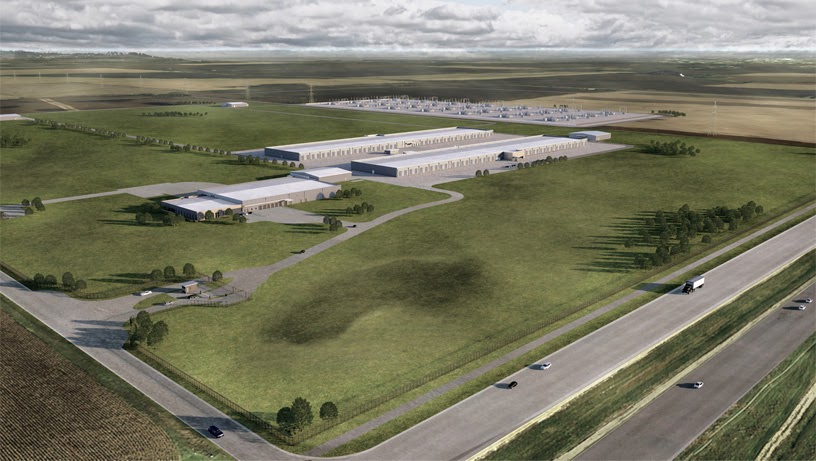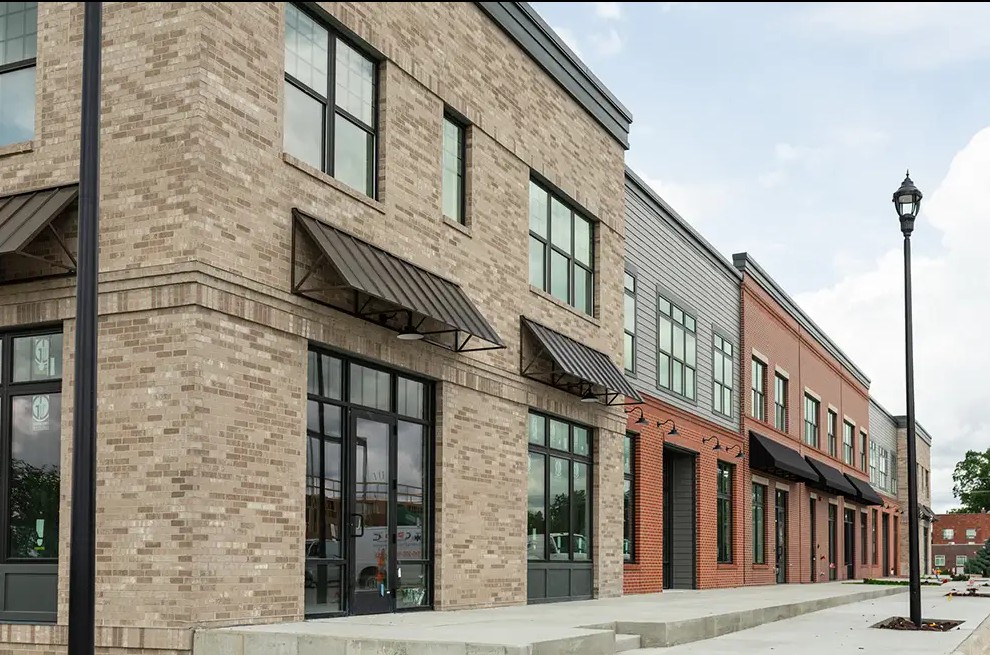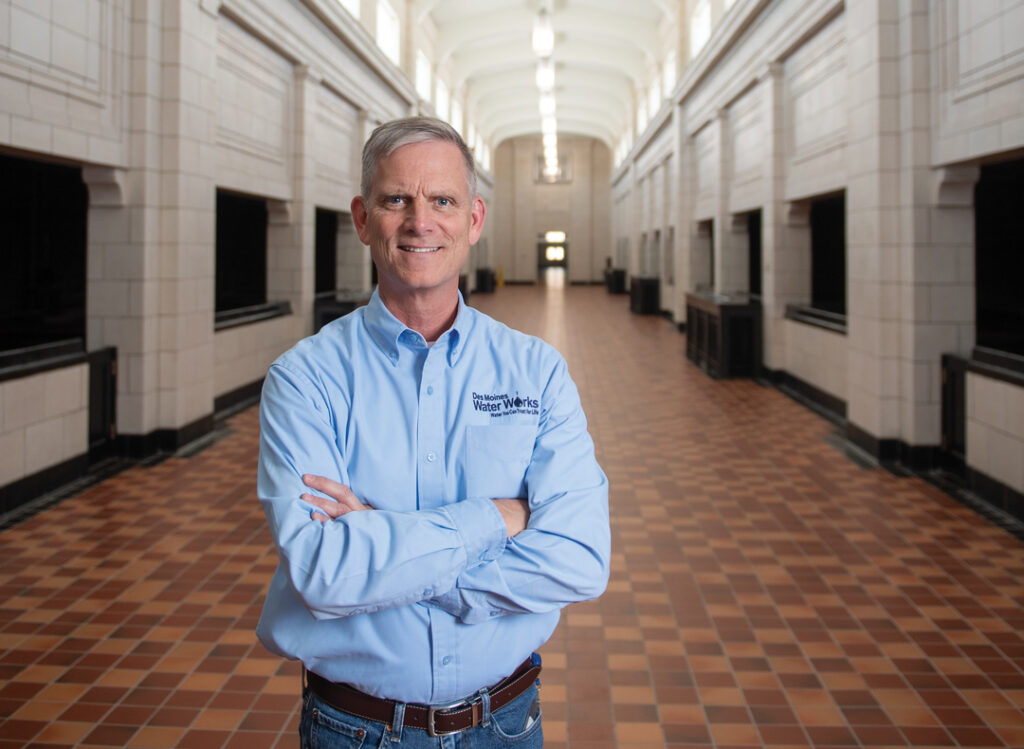Industrial Roundtable Q&A – 2019 Annual Real Estate Magazine
Still growing

KENT DARR Apr 17, 2019 | 8:10 pm
20 min read time
4,815 wordsBusiness Record Insider, Real Estate and DevelopmentFrom “circus tents” that provide temporary warehouses to cavernous high-tech buildings, the industrial sector is booming.
Follow the exits off Interstate 35/80 from Grimes to Ankeny to Norwoodville, and you’ll spot new construction all along the way.
The north is the place to be. It has the workforce and easy access to the metro’s crisscrossing interstate system to attract development, and that development is being made possible by investors — including pension funds and other institutional types — that are drawn to the sector.
Before users land in Greater Des Moines, they are on the lookout for more than land. They are weighing the workforce as well.
The rapid adoption of artificial intelligence is a dominant theme in the sector, and millennials who are tech-savvy make just the kind of labor pool that warehouse users are after.
Warehouse properties do not last long on the market. Quick sales are on a cycle that keeps repeating itself and is helping to drive up purchase prices.
Demand is so great that the conversion of vacant big-box retail spaces to warehouses is on the horizon. Does that mean we’ll see semis pulling in and out of a vacant Younkers at Merle Hay Mall? It’s a possibility.
The conversion of shuttered shopping centers to distribution centers is occurring in other parts of the Midwest.
Warehouses are becoming easier on the eyes, it seems, with some stonework and large windows a constant theme. It was noted during our panel discussion that some warehouse centers have the look of fancy office buildings.
Warehousing and manufacturing continue to be the dominant uses for industrial spaces, but don’t be surprised to find office users and entertainment centers.
Watch the roundtable video in its entirety here. Watch the other four videos at businessrecord.com/arem.
Brian Clark: One out of the gate is, I think, the labor location. A few large companies are not just looking at location for landing in Central Iowa but focusing on where they can grab labor. And we’re seeing the northern side of the metro being a strong draw for these companies to attract the labor they need for these large distribution centers. I think that trend will reveal itself more in 2019.
Kevin Crowley: I agree with Brian 100 percent on that. Also, employers are drawn to the amenities that the north side offers that really some other parts of the industrial sector do not offer. Another trend that we’re going to really see in 2019 is artificial intelligence driving the use of industrial space, so tighter racking, automated forklifts, and other technology that will be driving the efficiency of warehousing.
Jackie Johansen: And I would agree and add to that that the investor pool is growing for industrial to be very strong for 2019. A growing amount of pension funds, even foundation endowment funds, are being more and more comfortable with commercial real estate and the industrial sector specifically, so lots of dollars of equity flowing.
Harrison Kruse: Maybe not in 2019, but here in the future we’re going to see more retail big-box converting to industrial use, especially with our e-commerce and fulfillment centers.
Put your money here
What makes industrial properties such attractive investments?
Crowley: Logistics is driving a lot of that, so part of it is actually both manufacturing but shipping and receiving. And then really the buzzword in the industry is the last mile. So I think you saw Amazon was running ads for people that wanted to start their own delivery service in markets where I can start Kevin Crowley’s Delivery Service tomorrow as long as I had a vehicle that Amazon deemed worthy of me running and they guaranteed you like $90,000 a year to run that delivery service. The last mile is really important, too. Some of the companies here in town that do what I’m going to call short or immediate logistics work are busier than ever.
What kind of spaces do they need?
Crowley: It really varies, but there is a company out of Ankeny that probably is operating out of 50,000 to 60,000 square feet. They have dock doors and dry beds so their vehicles are constantly moving.
Clark: We’ve seen a concept that’s been more like a tent, a large circus-like tent that would be over a couple acres that would keep the weather out for a short duration, but [would] get your holiday packages processed and delivered on that last mile concept.
Crowley: There’s been times where we’ve seen Walmart take temporary space for Christmas rush; the U.S. Postal Service in Greater Des Moines is always looking for an extra 60,000 to 100,000 feet at Christmas just to handle the logistics of their extra business, so it’s not unusual.
However, with the tighter market with low inventory, it does present challenges that really something like Brian’s talking about where something temporary could pop up, although vacancies like the Younkers store, or Southridge, or Merle Hay could create opportunities too. On the East and West coast a lot of malls are being repurposed into residential housing complexes where they have senior housing, they have student housing, and they really mix up the use. But at the same time a good alternative for the right piece of real estate will be using an Amazon-type company, using a space to deliver product out of.
Kruse: Our CBRE report said that there’s been about 8 million square feet of retail either torn down and repurposed into about 11 million square feet of industrial logistics properties across the U.S., more in the major markets but it could happen in ours.
Johansen: These third-party logistics companies that are doing this reverse logistics work and all the returns, they had over half of the largest leases in the nation, over 7 million square feet.
There’s a lot of new construction in the industrial sector, yet vacancies remain low. Why?
Crowley: It’s really 1 million square feet of build-to-suit activity and probably almost 1 million square feet of speculative space.
They’re backfilling as quick as they want. We’ve done leases with a plastics company that came in from out of state and they took some space out in Urbandale, just really backfilled space that had been vacated. There’s really no lack of tenants, whether they’re local, regional or national tenants.
Kruse: We’ve seen the local guys grow the big chunk space as primarily more your national credit, third-party logistics and the other third-party distribution centers.
Johansen: It seems to me when I’m just looking at sales on the assessor site for that sector that there’s a very good strong percentage of out-of-state ownership.
Clark: Industrial is still kind of the preferred asset class among investors. Northern Tool is coming to the market with 635,000 square feet in phase one. There’s a pool of investors who have already indicated interest in buying that lease.
Is the demand for warehouse space a national trend?
Crowley: It really is around the country. It doesn’t matter if you talk to brokers in Kansas City, Indianapolis, Chicago, even Chicago for a while was at probably 20, 25 percent vacancy because everybody started developing out in the suburbs and that’s all full now. We’re not a unique island here. The same phenomena is happening all over the United States, and it has to do with shipping and receiving in manufacturing.
Johansen: But would you agree that most of that is around a fairly major metro market?
Crowley: It’s really metro-driven. The rural real estate market is still challenged. You’ll have spectacular facilities that sell for pennies on the dollar in rural parts of Iowa just because, again, it can be a labor issue, there just could be a lot of different drivers to what really causes that.
Kruse: Yes, the larger metropolitan areas are definitely growing the fastest, but our smaller markets still need the industrial and we can’t find it. Construction is still expensive and you can’t get the lease rates low enough to attract them. They can still find a building here in Des Moines or Cedar Rapids at the same price.
Clark: We’re seeing the national investors focus in the larger cities, and in the more smaller markets you’re seeing more local investors or lesser-known investors.
Will the use of artificial intelligence displace warehouse workers?
Johansen: These automated systems increase the productivity of the employees. Early on in my career I managed assembly lines for a manufacturing team and I even drove a forklift, so I can say I’ve taken pallets down from about five stories up. But I can’t imagine doing anything like that with a 40-foot ceiling, so you almost would have to have guided systems to really make that more productive. The skill set that you need for your employees is different than what it was 25 years ago. And then most likely you need more, especially if you’re doing fulfillment. There are a couple of companies that I’ve just been watching that have been installing these automation systems. One of then in Germany has about eight racks of full pallets with over 9,000 locators just in those eight aisles. Then they have about four aisles of what they call mini-loads, so they’re more like bins, and that has 26,000 locators. So they have what in my day back in warehousing we used to call a water slider. I don’t know what the role is called anymore, but basically they would allow the employees to stay at their station where they’re adding value to product and then moving it off to the next employee that’s adding a different kind of value. And they get to stay put while somebody else brings all of their pieces and widgets and items to them. So it’s just almost like it was 25 years ago on steroids with all of these guided systems and things moving all over the place.
Crowley: With the technology they have today, they’d literally fill a bin and then it can be scanned going onto trucks so they know what went into that particular truck. I mean the inventory controls are tighter and what they call breakage is less than probably 1 or 2 percent in terms of loss.
Why have the south-side industrial properties been slow to fill in?
Crowley: My conjecture is that these companies understand the cost of moving the product a mile. And so right now it’s more convenient to be on the north side of Interstate 80, whether you’re in Altoona, Ankeny, Grimes, Urbandale, along that corridor that’s just a more efficient corridor for these people to operate out of as far as shipping, receiving and where labor is, where our employees can go get lunch, where employees can get services before and after work. I think that is what has driven people to the north side. As the south side grows residentially and with retail, I think then the industrial and jobs will follow.
Clark: It’s an evolution. There was a time when the north side of Des Moines wasn’t as robust as it is now and it was all in the Delaware Avenue corridor or something. So it’s just a matter of time before the populations and the amenities and resources catch up, whether it’s the east side or south side.
Johansen: And the intermodal inland ports drive where industrial goes as well, so if you look at other inland ports like Dallas and Phoenix and Denver, about 3 percent to 12 percent of growth in warehouses is based on where those [intermodal] spots are located. So if we’re spending $15.2 million on the Des Moines facility and if that continues to grow, we’ll have four different rail lines, which is much more than what most of the nation has.
What’s that warehouse going to cost me?
Is the square-foot price for industrial the best price on the market right now?
Clark: Compared to corporate office, yeah. Yeah, I mean you can do a large-scale office or warehouse project for $55 a square foot; and as the square footage comes down, that price becomes $75 a square foot.
Kruse: And I’ve seen 5,000-square-foot buildings with flex space, and they’re all above … north of $100, $120.
Crowley: So we actually just sold a building in Grimes that somebody built thinking that they were going to use it for their business and it did not have heat in it, it did not have a restroom in it; it had two garage doors and a main door. And so we sold it as a cold storage warehouse, and literally the person who’s buying it is going to finish it, but we listed for $110 dollars a square foot and when we listed it my broker sarcasm was saying, “This is not gonna sell for $110 dollars a square foot,” and probably 14 days later we had a full-price offer. It was sold. That cycle keeps repeating. We sold a parking lot with a small truck service building in Grimes, and there were multiple bidders. And we literally just said we’ve had a number of contests among brokers and if everybody’s playing straight they say, “Here’s the list price, make your best offer,” and you better advise your client you better be $50,000 or $100,000 over list price or you’re not going to get it.
There was a building that Harrison listed and we literally legitimately made an offer about an hour after they listed and it was above list price and they sold it for about 20 percent over list price to someone that needed it more than my client did.
Kruse: Yeah, we got it sold in 24 hours. We had 12 or 15 offers on it; we had offers in our inbox within 20 minutes of it being blasted out to the brokers. It was pretty incredible.
Crowley: And we continue to see that. We just sold a building in Urbandale — it’s just a small little flex building, and literally we listed it and it sold within 24 hours.
Kruse: The small industrials, the owner-user industrials, are just flying off the shelf.
Crowley: Because the cost of construction, cost of even development ground, it’s almost prohibitive to try to put in sewer, water and utilities and then say, “OK, I have a 3-acre site I can sell you” because it’s going to be probably $5 dollars a square foot for industrial dirt once it’s developed.
Kruse: Well, I mean it’s tough with city requirements too; it’s hard to find a metal building site that you can build on. Most of these now, you have to put stone on at least 25 percent of the front facade or more, or they require tilt-up concrete.
Clark: Yeah, precast is a minimum now on these industrial buildings.
Crowley: And what’s really amazing is watching over the years product has been priced by the year it was built and so there’s $2.40 square foot triple net. There was $3 triple and there’s $3.50 triple, and now new product is usually coming in between $4.75 and $5.75 a square foot triple net.
Well, that’s giving landlords the opportunity to actually raise rents, which is something that we hadn’t seen for years in Des Moines. We’re seeing that in office space too; you’re approaching $20 or $25 net rents in new office construction. On industrial you’re still seeing the same thing, where some of the older industrial space as it turns over might have been leasing for $3 a square foot. The landlord might do nothing to the space and raise the rent 50 cents.
And then we’re also seeing the annualized bumps in leases, which we haven’t seen in Des Moines for years.
How flexible is flex?
You mentioned flex. Are nontraditional users still making up a big part of that market, or were they not a big part of that market to begin with?
Crowley: I think Hy-Vee’s use of the R&R building has been a big topic of conversation and it’s a great use for that space. It’s creative, it’s unusual. There aren’t that many people that can make that work for them because I think you’d find by cost per square foot, by the time they got done they could have had an office building or pretty close.
Are the nonprofits, fitness centers, those alternative uses, are they active in the market?
Kruse: You’ll continue seeing the entertainment uses in most spaces like you see at Hubbell’s Grimes Business Park.
Johansen: Go-karts.
Kruse: You’re going to have go-karts, you’re going to have a baseball facility for training, you’re going to have basketball, you name it. The sport, the training, the activity for younger kids, that stuff is going to continue being hot just because of the way we live now. We want entertainment.
Johansen: And back to Kevin’s point when you’re talking about these amenities and things like that at the Hy-Vee space and you are seeing an interest in office-type amenities in warehouse facilities. And to keep the employees happy, they’re more productive, they get a fitness center where maybe you didn’t usually see a fitness center in a warehouse facility, and more natural light, good ventilation, just your basics that in the office world are a lot of talk right now, a lot of design features, you’re starting to see in warehouse.
Clark: Deere ISG, I think, will come online this April, and Deere really wanted that industrial look and price. But then in certain areas within that for their tech employee base, they wanted to spend a little more money on the inside of the building than the outside, so the exterior is a very simple precast box and more of the amenities are being spent to make it less industrial on the inside, that new tech office space.
Are the state-certified sites attracting industrial users?
Crowley: There’s a cost to getting your sites certified. However, time kills deals. If we represent a buyer and all of a sudden the soil tests are done and you know where the sewer is, you know where the water is, you know where the utilities and the electrical is located, what Internet service is available. So the certified, shovel-ready sites are really important.
Clark: Yeah, I agree. A lot of the out-of-state users or clients will go there first or to what certified sites are available in this geographic region. Some cities are now in the process of creating those sites, and they’ll have a leg up over other cities. We’re seeing some national activity focus on some of those sites.
Kruse: Minimizes risk and time.
Johansen: Now what needs to be added to that is where the labor pool will come because site selectors are looking for labor pool.
Are your clients concerned about the [low] unemployment rate?
Crowley: Well, I think there’s a two-sided coin in that it’s worse in other parts of the country, so we’ve actually seen companies looking for programs come to Central Iowa to open up an office because they can hire someone here for a lower cost than they can in Austin or San Jose, Calif. So they’re coming here and then they’re trying to poach the insurance companies and some of the other companies. They are poaching employees but they’re doing it because they can pay more here that’s still less from other markets they’re in. And so, yes, we do have employers that also want to say, “Gee, it’s hard to get employees” or “It’s hard to do it industrially.” I know that a lot of these companies that use temps, they have high standards for drug testing and they lower the standard and they now accept certain drugs in their testing that they never did before.
Clark: And one of our clients, Northern Tool, picked the Ankeny site because they felt there was a labor shortage but felt like paying them a higher than average wage to compete with others to gravitate toward their business.
Kruse: Go back to amenities. I mean there’s a lot of discussion of places with fully air-conditioned warehouses because if there’s a competitor across the street that doesn’t have AC in the warehouse, that employee will come over for the exact same pay to be in AC. So it’s like the office market to where you have to have amenities to continue keeping your workforce happy and staying with you.
Johansen: And obviously there’s a significant cost to those kinds of amenities.
The opportunity zone challenge in rural Iowa
Johansen: I feel like there’s a lot of industrial comp-planned land in opportunity zones across Iowa. So now a lot of that is in rural cities, so the land price will be good. So where is the labor pool, where are the developers, where are the investors that want to be in those towns? But yet at the same time you can’t ignore there’s a lot of industrial land inside of those zones.
Crowley: But again it gets down to the economics and the logistics of it. We were working with a company and said we have a perfect facility for your truck service center and your distribution center. It was literally nine miles away and they said 750 trucks a day, 75 cents a mile, 18 miles a day, we can build exactly what we need on our site and pay for it in three years instead of driving across town. And so I mean that’s the reality, and again that just goes to show that’s the challenge of rural Iowa. And if rural Iowa can somehow with technology compete and have some workforce, maybe there’s third-party work they’re going to be able to do. Years ago I know there were leaders and companies [who said], “I grew up in a small town; I’m going to go back there and build a factory as an honor to my hometown and create jobs.” The population is not there to really help with that factory anymore and then logistics-wise it makes no sense, so people aren’t going to do it, it’s going to be harder to make that happen.
Kruse: It’s hard for an investor to go into a small city like that without security. So I think there’s potential for your local companies that are already there. I just don’t see it drawing a Des Moines company or a national company.
Clark: I would ask the state to redo the opportunity zone process. I’m a small-town guy, but awarding opportunity zones to communities where there’s no labor force, there’s no access — they are probably just going to sit.
Industrial Takeaways
Opportunity zones might miss the mark in rural Iowa
Here’s a plan that sounds so good it just might work: Defer, reduce or eliminate taxes on unrealized capital gains by investing that surplus in opportunity funds, which in turn trigger economic development projects in opportunity zones.
That tax-eluding enticement was included in the 2017 rewrite of federal tax laws. The zones are located in low-income census tracts. There are two in Des Moines near Drake University and one in the Valley Junction neighborhood of West Des Moines. There are nearly 100 scattered around the state, mostly in rural areas. Once designated, the zones are in place for 10 years.
Our panelists like the concept, but worry that opportunity zones might have trouble gaining much purchase in some parts of the state.
“The land price will be good. So where is the labor pool, where are the developers, where are the investors that want to be in those towns?” said Jackie Johansen of Shattered Glass Development. “At the same time, you can’t ignore there’s a lot of industrial land inside of those zones.”
Harrison Kruse of CBRE|Hubbell Commercial thought that land might be most attractive to businesses located near it.
“I think there’s potential for your local companies that are already there. I just don’t see it drawing a Des Moines company or a national company,” Kruse said.
Kevin Crowley of NAI Iowa Realty Commercial said a recent client asked why it should settle for a facility farther away when it can invest in a current location and pay its redevelopment bill in a shorter period of time.
Brian Clark of Ryan Cos. US Inc. thought the whole process of designating opportunity zones could be reconsidered. As it stands, sites were recommended by local officials and vetted by the Iowa Economic Development Authority, with the final selection coming from Gov. Kim Reynolds.
“I would ask the state to redo the opportunity zone process,” he said. “I’m a small-town guy, but awarding opportunity zones to communities where there’s no labor force, there’s no access — they are probably just going to sit.”
Chillin’ on the north side
The hunt for workers in the highly sought last mile of delivery has taken a decided turn to northern Greater Des Moines.
It won’t always be that way — all of that land eventually will be filled and developers will look elsewhere. Still, the trend is to go north. It is driven in large part by a concentration of workforce and amenities.
“We’re seeing the northern side of the metro being a strong draw for these companies to attract the labor they need for these large distribution centers,” said Brian Clark of Ryan Cos. US Inc.
In many cases, the amenities are similar to those being offered in the office sector, such as restaurants and entertainment. Residential growth is not only good for retail in those areas, but it also provides workforce.
Some amenities might not be immediately apparent.
“There’s a lot of discussion of places with fully air-conditioned warehouses because if there’s a competitor across the street that doesn’t have AC in the warehouse, that employee will come over for the exact same pay to be in AC,” said Harrison Kruse of CBRE|Hubbell Commercial. “So it’s like the office market to where you have to have amenities to continue keeping your workforce happy and staying with you.”
The millennial effect
Millennials are shaping virtually every sector of the real estate market, including the push to cut the last mile from warehouse to doorstep.
“Thirty -nine percent of Amazon Prime members are millennials, so that’s where a lot of the demand of wanting things in two hours is coming from,” said Jackie Johansen of Shattered Glass Development.
“They’re driving the last mile,” said Brian Clark of Ryan Cos. US Inc.
Kevin Crowley said millennials make up a workforce that is attractive to warehouse users.
“The artificial intelligence and the technology helps the industrial users a little bit on employees because a lot of millennials or Gen Zs really like technology. They might be a good fit for fixing the AI or computerized systems,” said Harrison Kruse of CBRE|Hubbell Commercial.
Clark had an anecdote to illustrate that point.
“We had a competition at Elder Corp. to run heavy equipment. The old guys did OK, but the young millennials who are used to operating video games, they were moving dirt. They won the competition because of their motor skills development. And millennials have been doing that since they were a kid so they’re a great labor force when it comes to that.”
Reverse logistics or e-charity
The panel touched a bit on reverse logistics. It’s trending in the warehouse and distribution market and describes centers that are set up to return online purchases.
So far there isn’t a lot of demand for such centers in Central Iowa, but that doesn’t mean we aren’t avid online shoppers. It’s just that e-commerce is providing alternatives.
Jackie Johansen, founder of Shattered Glass Development, said about 8 percent of in-store purchases are returned. That number jumps to 15 to 30 percent for e-commerce purchases.
Johansen said she isn’t a big online shopper, but has had a couple of experiences with attempting to return purchases that she has made. “They don’t want it back,” she said.
“One was a large dog bed and they said, ‘Take it to your local animal shelter if you would and we’ll send you the next one.’ And I’ve had that on the boutique side before — ordered a garment that didn’t fit right and I called and they said, ‘Donate it, we’ll send you a new one.’ ”
And besides, many online retailers have returns covered.
“If you’ve got an Amazon package, there’s literally instructions in the packet how to send it back,” said Kevin Crowley of NAI Iowa Realty Commercial. “There’s probably a specialty group within Amazon that just deals with returns.”










